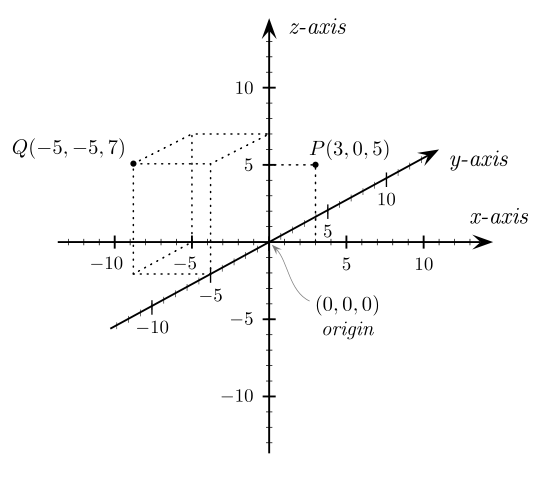Summary
Example for en:Cartesian coordinate system. Created by Gustavb using en:PSTricks.
Licensing
I, the copyright holder of this work, have published or hereby publish it under the following license:
 |
Permission is granted to copy, distribute and/or modify this document under the terms of the GNU Free Documentation license, Version 1.2 or any later version published by the Free Software Foundation; with no Invariant Sections, no Front-Cover Texts, and no Back-Cover Texts. A copy of the license is included in the section entitled " GNU Free Documentation license".
Aragonés | العربية | Asturianu | Беларуская (тарашкевіца) | Български | বাংলা | ইমার ঠার/বিষ্ণুপ্রিয়া মণিপুরী | Brezhoneg | Bosanski | Català | Cebuano | Česky | Dansk | Deutsch | Ελληνικά | English | Esperanto | Español | Eesti | Euskara | فارسی | Suomi | Français | Gaeilge | Galego | עברית | Hrvatski | Magyar | Bahasa Indonesia | Ido | Íslenska | Italiano | 日本語 | ქართული | ភាសាខ្មែរ | 한국어 | Kurdî / كوردی | Latina | Lëtzebuergesch | Lietuvių | Bahasa Melayu | Nnapulitano | Nederlands | Norsk (nynorsk) | Norsk (bokmål) | Occitan | Polski | Português | Română | Русский | Slovenčina | Slovenščina | Shqip | Српски / Srpski | Svenska | తెలుగు | ไทย | Tagalog | Türkçe | Українська | اردو | Tiếng Việt | Volapük | Yorùbá | 中文(简体) | 中文(繁體) | +/- |
|
Source
Cartesian_coordinates_3D.tex (PSTricks source)
\input pst-eps\input pst-plot\input pst-node\TeXtoEPS
\psset{linecolor=black,linewidth=1pt,arrowsize=8pt,unit=0.29cm}
\pspicture*(-17,-15.3)(17,15.3)
% Axes
\psaxes[Dx=5,Dy=5,showorigin=false]{<->}(0,0)(0,-14.5)(14.5,14.5)
\psaxes[Dx=5,Dy=5,showorigin=false,labels=none]{<-}(0,0)(-14.5,0)(0,0)
\psline{<->}(11,6)(-11,-6)
\multips(0,0)(3.7931,2.0689){3}{\psdots[dotstyle=|,dotscale=1.5](0,0)}
\multips(0,0)(-3.7931,-2.0689){3}{\psdots[dotstyle=|,dotscale=1.5](0,0)}
\psset{linewidth=.4pt}
\multips(0,0)(.75862,.41379){14}{\psdots[dotstyle=|,dotscale=1](0,0)}
\multips(0,0)(-.75862,-.41379){14}{\psdots[dotstyle=|,dotscale=1](0,0)}
\psaxes[Dx=1,Dy=1,ticksize=1.5pt,labels=none](0,0)(-13,-13)(13,13)
\uput{10pt}[0](0,14){\psscalebox{1.25}{\it z-axis}}
\uput{10pt}[75](14,0){\psscalebox{1.25}{\it x-axis}}
\uput{5pt}[330](11,6){\psscalebox{1.25}{\it y-axis}}
\uput{8pt}[255](-10,0){$-10$}\uput{8pt}[255](-5,0){$-5$}
\uput{8pt}[270](3.7931,2.0689){$5$}\uput{8pt}[270](-3.7931,-2.0689){$-5$}
\uput{8pt}[270](7.5862,4.1379){$10$}\uput{8pt}[270](-7.5862,-4.1379){$-10$}
% Origin
\pnode(0,0){O}
\uput{35pt}[310](0,0){\rnode{Ot}{\psscalebox{1.1}{
\vbox{\halign{\hfil#\hfil\cr$(0,0,0)$\cr\it origin\cr}}}}}
\nccurve[angleA=315,angleB=155,arrowsize=4pt,
nodesepA=2pt,nodesepB=-1pt,linecolor=gray]{<-}{O}{Ot}
% Points
\psdots[dotstyle=*,dotscale=1.2](3,5)(-8.7931,5.0689)
\psset{linestyle=dotted,linewidth=.8pt}
\psline(3,0)(3,5)(0,5)
\psline(-3.7931,-2.0689)(-8.7931,-2.0689)(-5,0)(-5,7)
(0,7)(-3.7931,5.0689)(-3.7931,-2.0689)
\psline(-8.7931,-2.0689)(-8.7931,5.0689)(-3.7931,5.0689)
\psline(-8.7931,-2.0689)(-8.7931,5.0689)(-3.7931,5.0689)
\psline(-8.7931,5.0689)(-5,7)
\uput{2.5pt}(3,5){\psscalebox{1.1}{$P(3,0,5)$}}
\uput{5pt}[140](-8.7931,5.0689){\psscalebox{1.1}{$Q(-5,-5,7)$}}
\endpspicture
\endTeXtoEPS
\nopagenumbers
\end
Instructions
- Create EPS
$ tex Cartesian_coordinates_3D.tex && dvips -E Cartesian_coordinates_3D.dvi
- Outline fonts
$ eps2eps -dNOCACHE Cartesian_coordinates_3D.ps Cartesian_coordinates_3D2.eps
- Fix bounding box
$ ps2epsi Cartesian_coordinates_3D2.eps Cartesian_coordinates_3D.eps
- Convert to Sketch
$ pstoedit -f sk Cartesian_coordinates_3D.eps Cartesian_coordinates_3D.sk
- Convert to SVG
$ skconvert Cartesian_coordinates_3D.sk Cartesian_coordinates_3D.svg
- Fix Cartesian_coordinates_3D.svg with Inkscape
Image history from en:
Click on a date/time to view the file as it appeared at that time.
The following pages on Schools Wikipedia link to this image (list may be incomplete):

